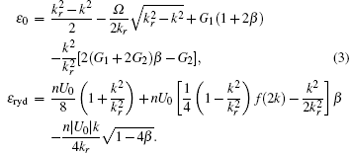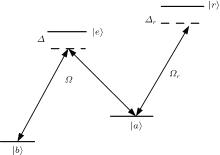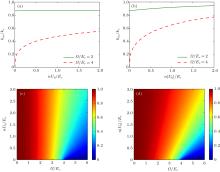†Corresponding author. E-mail: jqian@mail.siom.ac.cn
Project supported by the National Basic Research Program of China (Grant No. 2011CB921504) and the National Natural Science Foundation of China (Grant No. 11104292).
Interaction between Rydberg atoms can be used to control the properties of interatomic interaction in ultracold gases by weakly dressing the atoms with a Rydberg state. Here we investigate the effect of the Rydberg-dressing interaction on the ground-state properties of a Bose–Einstein condensate imposed by Raman-induced spin–orbit coupling. We find that, in the case of SU(2)-invariant s-wave interactions, the gas is only in the plane-wave phase and the zero-momentum phase is absent. In particular, we also predict an unexpected magnetic stripe phase composed of two plane-wave components with unequal weight when s-wave interactions are non-symmetric, which originates from the Rydberg-dressing interaction.
A variety of exotic phenomena in condensate matter systems have their physical origin related to the electrons experienced by an external gauge field or in the presence of spin– orbit coupling (SOC), which is crucial for quantum spin Hall effect, topological insulators and superconductors.[1– 4] Neutral atoms originally do not have SOC effect, however, in the past few years synthetic SOC has been generated for ultracold atoms by engineering atom– light interactions.[5– 10] In fact, quantum gases are good candidates to investigate the interplay between interaction and SOC in many-body systems and exotic quantum phases have been observed with Bose– Einstein condensates (BECs) and degenerate Fermi gases.[11– 19] Furthermore, rich ground-state phases such as meron spin configuration and quantum quasicrystals have been predicted in dipolar spin– orbit-coupled gases.[20, 21] In the present work we are instead interested in the ground-state properties of quantum gas under the effects of long-range interaction and synthetic gauge fields. Recently, great achievements have been made in manipulating the atoms several micrometers apart by engineering long-range interactions especially when the atoms are excited to a high-lying Rydberg state.[22– 25] Strong van der Waals (vdW) interaction between Rydberg states and off-resonant coupling between ground and Rydberg states lead to Rydberg-dressing interaction subject to degenerate quantum gases, which may lead to the supersolidity of the dressed gas as a result of roton minimum and blockade effect.[26, 27] Moreover, dipole-mediated energy transport by Rydberg interaction[28] and spatially ordered excitations[29] have been observed recently, which demonstrate the potential of Rydberg gases to realize exotic phases of matter, thereby paving the way for quantum simulations of strongly correlated systems with long-range interactions.
We consider a Bose– Einstein condensate (BEC) of rubidium atoms with a Λ -type Raman-transition configuration, as shown in Fig. 1. Two spin states | a⟩ = | 5S1/2, F = 1, mF = 0⟩ and | b⟩ = | 5S1/2, F = 1, mF = − 1⟩ are coupled to an excited state | e⟩ respectively by 804-nm Raman beams which intersect at the angle 90° .[6] The recoil energy is Er = h × 1.77 kHz. In order to introduce the long-range interaction, we couple the state | a⟩ to a high-lying Rydberg state | r⟩ via a two-photon process (for example, choosing | 43S1/2⟩ state as the states | r〉 and | 5P3/2〉 as the intermediate state). Effective Rabi frequencies and the detunings of the Raman and Rydberg transitions are Ω , Ω r, Δ , and Δ r, respectively. In the off-resonant coupling regime, i.e., Δ r ≫ Ω r, the Rydberg state | r〉 can be adiabatically eliminated, which results in an effective soft-core interaction 

Considering an interacting spin-1/2 BEC in Fig. 1, we have the mean-field energy functional (we set ħ = m = 1)

Here, Ψ = (Ψ a, Ψ b)T is the two-component condensate wavefunction. The inter- and intra-component interactions are characterized by the coupling strengths gij = 4π aij (i, j = a, b) with aij the corresponding s-wave scattering lengths. The first term corresponds to Raman-induced SOC Hamiltonian

with the Pauli matrices σ x, y, z and kr the wave vector. For Ω < 4Er, degenerate minima appear in the dispersion relation capable of hosting a condensate with 
In general, the ground-state wavefunction can be determined by minimizing the total energy Eq. (1) with the following ansatz:[33, 34]

where n is average density and k ≥ 0, C± , θ , and k are variational parameters and the normalization constraint | C+ | 2 + | C− | 2 = 1 should be satisfied. A general relation cos(2θ ) = k/kr is fixed by minimizing the single-particle Hamiltonian ĥ 0 with respect to k. Using Eq. (2), one can calculate spin polarization as ⟨ σ z〉 = n(| C+ | 2 − | C− | 2)/(k/kr). Substituting Eq. (2) into Eq. (1), we obtain the mean energy ε = ε 0 + ε ryd per atom

Here, we have defined the quantities G1 = n(g + gab)/4, G2 = n(g − gab)/4, and β = | C+ C− | 2. The ε 0 represents the mean energy contributed from the SOC and atomic s-wave interactions, while ε ryd is the Rydberg-dressing interaction. U(k) = U0f(2k) with U(0) = U0 is Fourier transformation of the soft-core interaction V(r), given by

As is well known, distinct quantum phases emerge without the Rydberg interaction, depending on the values of the relevant parameters kr, Ω , gij, and n. For small values of Ω and G2 > 0, the condensation hosts the superposition of two plane-wave (PW) states e± ikx with equal weight (β = 1/4 and 〈 σ z〉 = 0) characterized with density-modulated stripes. This is so-called standing-wave (SW) or stripe phase.[33– 36] For larger values of the Raman coupling, the condensate is in a single PW state with a finite momentum (i.e., px = ± k ê x with β = 0 and 〈 σ z〉 ≠ = 0). At even larger Ω , the degenerate momenta merge and zero-momentum phase forms spontaneously.[36]
From now on, we are interested in the effects of the long-range Rydberg-dressing interaction on the ground-state quantum phases of the spin– orbit coupled atomic gases. Firstly we consider the simplest case with symmetric s-wave interaction strengths, i.e., G1 = ng/2 and G2 = 0. By using the variation method, we find that the ground state requires β = 0 and the mean total energy reduces to

Here, 
For example, we choose two cases with Ω = 2Er, 4Er and give the values of km as a function of the Rydberg interaction strength in Fig. 2. Since in this situation the s-wave interactions are SU(2)-invariant, the s-wave interaction energy is momentum-independent now. The ground state is totally determined by the single-particle and Rydberg-dressing interactions. In the case of the repulsive Rydberg interaction, for a small Ω , there are two minima of the energy and the ground state of the condensate is still in the PW phase. With increasing U0, km grows slightly. When the Rydberg interaction is attractive, however, km grows obviously but no more than kr. For a large Ω , an intriguing feature is that the zero-momentum phase is energetically unfavorable and the PW phases with ± km emerge since Z2 symmetry is broken by the Rydberg interaction. For Ω ≥ 4Er, we can see from Eq. (4) that ε 0 has a minimum at k = 0 while ε ryd has a maximum at k = 0. Therefore the total energy has its minimum at a point with km > 0 to make ε as small as possible. If U0 = 8Er, km can be calculated exactly as 
Once the ground-state wavefunction is obtained, the spin polarization | 〈 σ z〉 | can be easily extracted as shown in Figs. 2(c) and 2(d). It is obvious that the gas is always magnetic for U0 ≠ 0 even for large Ω in both of the repulsive and attractive Rydberg interaction cases. In particular, when Ω > 4Er, an unexpected transition from the non-magnetic phase to the magnetic phase is revealed, which is absent for an s-wave interacting spin– orbit coupled atomic gas. At this time, the system is in the PW phase and | 〈 σ z〉 | is equal to km/kr since β = 0, so we always have | 〈 σ z〉 | ≠ 0 since km changes to be non-zero as illustrated above.
Now we are in the position to analyze the interesting G2 > 0 case, for example, G1 = 0.4Er and G2 = 0.1Er. Without the Rydberg-dressing interaction, the system undergoes phase transition between three distinct phases at two critical values as varying Ω . The system is in the SW phase when Ω < Ω 1 = 2.4Er and in the zero-momentum phase for Ω ≥ Ω 1 = 3.6Er, in which the spin polarization of the condensate is zero, while the condensate is in the separated PW phase with non-zero 〈 σ z〉 for a moderate Ω ∈ (Ω 1, Ω 2).[33] In Fig. 3 we plot the ground-state phase diagram and spin polarization for both the repulsive and attractive Rydberg interactions. For large Ω , whether repulsive or attractive, the system is always in the PW phase and | 〈 σ z〉 | proportional to km grows with increasing | U0| . Especially when Ω ≥ 4Er, similar to the case of G2 = 0, the energy evolves continuously from having single minimum (zero-momentum) to having two degenerate minima as increasing | U0| . Accompanied with the PW phase, the system becomes magnetic. The reason is the same as that of the G2 = 0 case.
Next we focus on the interesting small Ω case in which the system should be favourable with the non-magnetic SW phase for U0 = 0. The ground-state phase diagrams are shown in Figs. 3(a) and 3(b). For U0 > 0, with increasing U0, the phase boundary between the SW and PW phases bends to small Ω because we find 


To analyze the influence of the Rydberg-dressing interaction, we fix the values of Ω and calculate the spin polarization as a function of Rydberg-dressing interaction strength as shown in Figs. 3(e) and 3(f) respectively. For Ω = 2Er, | 〈 σ z〉 | jumps up abruptly, which indicates the phase transition from the SW phase to the separated PW phase. The phase transition is first-order because | 〈 σ z〉 | can be treated as an order parameter[19] and is not a continuous function of U0. Particularly, in the SW phase | C+ | 2 ≠ | C− | 2 with 0 < β < 1/4 and the condensate becomes magnetic, which can only be attributed to the Rydberg interaction. Since na = | Ψ a| 2 = n[| C+ | 2 cos(2θ ) + | C− | 2 sin(2θ )] is proportional to 1 − | 〈 σ z〉 | , the | a〉 atoms experienced by the Rydberg-dressing potential tend to transfer to the state | b〉 to reduce the total energy. Once n| U0| exceeds a critical value, the system enters the magnetic PW phase with the momentum km or − km. For the cases of Ω = 3Er and Ω = 4Er, the gas is always in the magnetic PW phase and the spin polarization of the BEC increases with increasing | U0| . At this time, the phase transition hardly happens. When Ω ≥ Ω 2 = 3.6Er, however, the Rydberg interaction inhibits the emergence of the zero-momentum phase and maintains the separated PW phase.
In summary, we have explored the ground-state properties of the Rydberg-dressing BEC imposed by synthetic Raman-induced SOC. In the case of SU(2)-invariant s-wave interactions, for large Ω , the zero-momentum phase is completely suppressed because it is unfavorable in energy compared to the separated PW phase in the presence of the k-dependent long-range Rydberg interaction. This feature also happens in the situation of non-symmetric s-wave interactions. Furthermore, an unexpected magnetic SW phase emerges with small Ω , which arises from the Rydberg-dressing interaction. We remark that the stability and excitation properties of the Rydberg-dressed condensate with SOC are further expected to investigate, and the effect of the long-range Rydberg-dressing potential with the roton nature on the unique stripe phase is particularly significant for potential applications. Our work may provide new insights into quantum gases with synthetic gauge field and long-range interaction.
| 1 |
|
| 2 |
|
| 3 |
|
| 4 |
|
| 5 |
|
| 6 |
|
| 7 |
|
| 8 |
|
| 9 |
|
| 10 |
|
| 11 |
|
| 12 |
|
| 13 |
|
| 14 |
|
| 15 |
|
| 16 |
|
| 17 |
|
| 18 |
|
| 19 |
|
| 20 |
|
| 21 |
|
| 22 |
|
| 23 |
|
| 24 |
|
| 25 |
|
| 26 |
|
| 27 |
|
| 28 |
|
| 29 |
|
| 30 |
|
| 31 |
|
| 32 |
|
| 33 |
|
| 34 |
|
| 35 |
|
| 36 |
|





